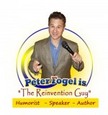As I mentioned in Part I, being specific sells and makes a story more personal. Give your audience a place to envision by telling them the specific location of your joke or story. For instance, say you were in Tommy's Diner in Hoboken, New Jersey -- as opposed to just saying New Jersey. Your audience will have a specific place to think about and will become more engaged. Here are some more tips.
6) Find a balance between details that people know and details that are too "inside" for a small group. If you're speaking to people you work with, talk about the company cafeteria and they'll be right there with you. Connect with larger audiences by drawing on nationally recognizable objects, brands, and places.
7) Find the right adjectives and verbs and then put your whole self into saying them. These are the words that make your stories come alive. You can practice this any time by describing objects and actions around you and seeing how emphasis can make the description even better.
8) Think Visually: Use very specific adjectives and verbs. For instance, say "bawling" rather than "crying," and "steaming" rather than "hot."
9) Memorize your stories. IMPORTANT: If you give away the climax or miss an important detail, it's hard to backtrack and make the story work. Rehearse a story at least thirty times in private before you practice it in front of an audience.
10) Use stories from your own life experience. You'll learn the story faster and tell it better. Best of all, your story cannot be snatched by another speaker since it has to do with your personal experience. Your goal is to always create a signature story that is yours and yours alone!
11) Reel the listeners in with good emotional language.
12) Craft your funny stories so that they conclude abruptly with a single word. After you speak that word, don't say another. You've worked hard for that laughter, and you need to let yourself and the audience enjoy it for a moment before moving on.
13) The only exception is with a story that doesn't really have a punch line but is funny the whole way through. These stories are usually used by comedians and humorists who are paid by the laugh and are supposed to be funny all the time. The bar does not have to be that high for you. Sprinkling your stories with just the right amount of humor will suffice, trust me on this!
14) Create the same story in different lengths to fit into different time slots. Instead of memorizing your story word for word, just remember the details you need to put in. Subtract or add detail to change the length of the story. As your platform and editing skills improve, you'll know how to do this instinctively.
15) A great trick is to have a short quote ready that makes the same point as your story. That way if you get cut short, you can take out the story and use the quote instead.
16) Change non-essential elements of your story to make a better connection with any given audience. You'll talk differently to a group of executives than you will to a group of schoolteachers.
17) Use terms to draw audiences into your story. Take your audience on a journey. Be as descriptive as you can when you weave your tale. Using powerful, hypnotic words as "Imagine this," "Have you ever experienced…" and "Come with me to . . ." are all good.
I hope my tips have helped you. If you've heard them before somewhere else or a variation of them… there's a reason. They work. Test out what works for you and discard what doesn't. The most powerful tool a speaker can use is to edit "out the fat" from their stories and presentations. Less is always more… make sure your presentation is lean and mean!
Peter "The Reinvention Guy" Fogel is a humorist, seminar leader, and speaker coach who helps entrepreneurs, writers, and emerging speakers reach their full potential as effective communicators. He is the author of the bestselling book, "If Not Now… Then When? Stories and Strategies of People Over 40 Who Have Successfully Reinvented Themselves" and the soon to be released book, "Reboot Your Career: 27 Ways to Reinvent Yourself in the Workplace… If You Still Have a Job!" For more info on his products and to sign up for his FREE 7 Days to effective Public Speaking E-course.. ($75 Value) Go to www.publicspeaklikeapro.com


